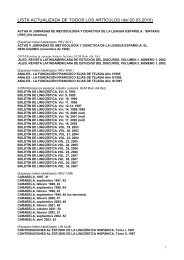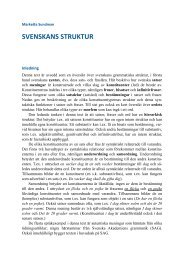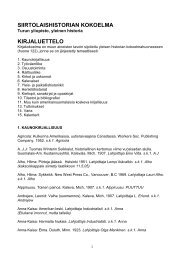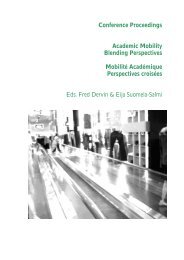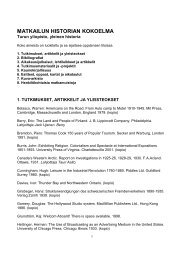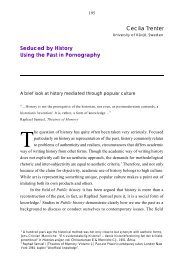Style sheet (pdf)
Style sheet (pdf)
Style sheet (pdf)
You also want an ePaper? Increase the reach of your titles
YUMPU automatically turns print PDFs into web optimized ePapers that Google loves.
STYLE SHEET<br />
FOR PAPERS AND THESES<br />
Department of English<br />
University of Turku<br />
2013-14
1 Introduction<br />
The purpose of this style <strong>sheet</strong> is to give general instructions about the format and<br />
organisation of written assignments at the Department of English. They are based on<br />
The Chicago Manual of <strong>Style</strong> (2003), which is regularly reviewed and updated. Should<br />
you need information that is not contained within this guide, please consult the<br />
manual.<br />
The instructions are formulated for word-processing programs. Where examples<br />
of the instructions are provided, they are placed in grey-shaded boxes for easy<br />
reference.<br />
Note that the guidelines in this style <strong>sheet</strong>, in particular those concerning the<br />
form of references, are those recommended by the Department of English; other<br />
departments may require that you follow a different system.<br />
For thesis writing, the Department has another guide, which includes<br />
information on the title page, abstract page and other structural aspects of theses.<br />
This MA thesis guide is available at www.hum.utu.fi/oppiaineet/englanti/studying/.<br />
2 Format<br />
2.1 Font<br />
The font for the text must be easily legible and not too small. The recommended font<br />
for the main body of the text is 12 points. Headings should be written in a larger<br />
font.<br />
2.2 Margins<br />
Use a margin of 2.5 cm on all sides of the paper. For MA theses, because they are<br />
bound, reserve a wider left margin, maximum 4 cm.<br />
2.3 Line spacing<br />
Use 1.5 line-spacing. Never use line spacing 1 or auto spacing. (But cf. below for<br />
quotations and examples.)<br />
2.4 Paragraphing<br />
Paragraph divisions may be indicated either by leaving a blank line between<br />
paragraphs or by indenting the first line of a new paragraph. Exception: if the<br />
paragraph follows a section heading, the first line is not indented.<br />
1
3 Organisation of the Text<br />
3.1 Sections and headings<br />
The paper should be reasonably divided into sections and, if necessary, subsections.<br />
The number of levels depends on the length of the work and the complexity of the<br />
subject matter. Please give all sections and subsections a heading and indicate the<br />
hierarchical level of the section by numbers (e.g. 2, 2.1, 2.1.1, etc).<br />
3.2 BA and MA theses<br />
The sections of a BA and MA thesis should be arranged as follows:<br />
Title page<br />
Abstract (MA theses only)<br />
Table of contents<br />
Lists of figures, tables, and abbreviations<br />
Body of the text<br />
References<br />
Appendices<br />
Finnish summary (for BA theses, this should be physically separate from the rest of<br />
the text)<br />
3.3 Figures and tables<br />
If you present facts in the form of figures (i.e. graphics) or tables, they should be<br />
numbered (e.g. Table 1, Table 2, etc.) in boldface, with their title in normal font; they<br />
are referred to in the text by their numbers (e.g. “See Table 4 for details”). All figures<br />
and tables should be self-explanatory: they should be understandable<br />
independently, without referring to the text (for instance, abbreviations used in the<br />
table should be explained in the legend of the table). Figures and tables should be<br />
relevant to your argumentation: the information they present should be discussed in<br />
the text. The example below is correct:<br />
Original Word Split Word<br />
Arbeitnehmer<br />
Treibhauseffekt<br />
Treibhauseffektgase<br />
Linguistic-based Corpus-based<br />
Arbeit Nehmer<br />
Treib Haus Effekt<br />
Treib Haus Effekt Gase<br />
2<br />
Arbeitnehmer<br />
Treibhauseffekt<br />
Treibhauseffekt Gase<br />
Table 2. Examples of splitting German words by English-speaking translation students
4 Typographical Conventions<br />
4.1 Examples and foreign words<br />
Examples of data in linguistic texts should be numbered with Arabic numerals<br />
between parentheses. Examples are set apart from the main body of the text on a<br />
separate line, with a blank line before and after, and indented. Examples should be<br />
single-spaced:<br />
(1) This is an example of how examples should be arranged in your paper or<br />
thesis. Note line spacing and indentation.<br />
(2) * Examples what is ungrammatical should be marked with an asterisk.<br />
A letter, word, phrase or sentence cited as a linguistic example or as a subject of<br />
discussion must be marked by italics. Similarly, cited forms in a foreign language<br />
should be marked by italics; they should be followed, at least at the first occurrence,<br />
by a gloss in single quotation marks:<br />
Separate is one of the most frequently misspelled words in the English language.<br />
One aspect of their national character that Finns are particularly proud of is sisu,<br />
„determination and resilience‟, as displayed by the entire people during the Winter<br />
War.<br />
4.2 Terms and Highlighting<br />
At the first occurrence of a term mark it with italics or single quotation marks:<br />
This paper discusses the differences between restrictive and non-restrictive relative<br />
clauses. Restrictive relative clauses can be defined as ...<br />
Or, alternatively:<br />
This paper discusses the differences between „restrictive‟ and „non-restrictive‟<br />
relative clauses. Restrictive relative clauses can be defined as ...<br />
For highlighting or emphasis use either italics or boldface but be consistent.<br />
3
5 Quotations and References in the Text<br />
The Golden Rule: Give Credit to Whom Credit is Due.<br />
5.1 When to do it?<br />
Data: When you are analysing or discussing primary data, always indicate the<br />
source. This includes data you have collected yourself.<br />
Research: When you make use of any work by other people, you must always<br />
indicate the source of the information; this also includes personal correspondence or<br />
conversations. Within the text, this usually means the surname of the author(s), the<br />
year of publication and the page number (see Section 5.2).<br />
There are three correct ways of making use of other people‟s studies: quotation,<br />
paraphrase and summary. Anything else is plagiarism or theft, which are illegal.<br />
5.2 Quotations<br />
All references must be provided in the running text and not in footnotes or endnotes.<br />
You may quote if you need to use the exact words of the original. For instance,<br />
this may be because the material is unique and memorable or because the original<br />
statement is well-written and more compelling than a summary or paraphrase of it<br />
would be. A quotation must match the original exactly. Even errors, such as<br />
misprints, must be reproduced; to show that the error is in the original, use [sic]<br />
after the relevant point.<br />
Below, there is a sample of an original text by Schlant. Several examples in this<br />
section will draw from it:<br />
Historians, political scientists, economists, and journalists are constrained (or ought to be)<br />
by facts, and other objective criteria, whereas literature projects the play of information,<br />
exposing levels of conscience and consciousness that are part of a culture‟s unstated<br />
assumptions and frequently unacknowledged elsewhere. Because they are unconsciously<br />
held, these assumptions provide greater insight into the moral positions at work than do its<br />
explicit opinions and images, which are often censored or the expression of wishful<br />
thinking. Literature lays bare a people‟s dreams and nightmares, its hopes and<br />
apprehensions, its moral positions and its failures. It reveals even where it is silent; its<br />
blind spots and absences speak a language stripped of conscious agendas.<br />
(Schlant 1999: 3)<br />
Every change, however trivial, should be indicated. You do so by using square<br />
brackets, as in the example below:<br />
Schlant claims that “[l]iterature [...] reveals even where it is silent; its blind spots<br />
and absences speak a language stripped of conscious agendas” (1999: 3).<br />
4
As in the example above, if the quotation is unnecessarily long for your purposes,<br />
you may use ellipsis (indicated by [...] to show that you have omitted something).<br />
You need not indicate ellipsis at the beginning or end of the quotation. The ellipsis<br />
marker should not be divided at the end of a line. Remember to use square brackets<br />
[… ] with ellipsis, not parentheses (… ). Punctuation in the original either preceding<br />
or following the ellipsis is normally retained. If the original includes such<br />
punctuation, you should mention it in your reference (see Section 5.2.1).<br />
5.2.1 Information to be included<br />
Quotations within the text should be supplied with the following information: author<br />
(not editor) year of publication: page number. Other relevant information should<br />
also be clearly marked, as in the following examples.<br />
Include the original publication date of unedited reprints, such as literary editions.<br />
In the following, the original publication is 1993; the edition used is from 1995:<br />
“I sat stupid for some time, and embarrassed you by my awkwardness” (Phillips<br />
[1993] 1995: 118).<br />
Include any emphases you add to make a particular point in the quotation clear:<br />
“I sat stupid for some time, and embarrassed you by my awkwardness” (Phillips<br />
[1993] 1995: 118; emphasis added).<br />
Mention that it is your own translation if no translation is available for a work<br />
written in a language other than English:<br />
“However, in no way should interpreting be based solely upon the concept of<br />
horizontal processing” (Tommola 2006: 22; my translation).<br />
Explain if the punctuation or capitalisation may cause confusion:<br />
Why do I still keep waiting and dreaming. Hoping . . . maybe . . . someday . . .<br />
(Sender 1986: 2; punctuation as in the original).<br />
5.2.2 Punctuation and layout of quotations<br />
Quotations within the text should be given in double quotation marks with the<br />
source reference supplied:<br />
5
Hale (2008: 9) explains that we “need a theory of ethnicity grounded solidly in<br />
psychological research on human behavior”, and that relational theory is of use in<br />
that regard.<br />
Note that, unlike Finnish, the final full stop in English is always placed after the<br />
reference (except in block quotations), regardless of the scope of the reference:<br />
Accordingly, he states: “[cohesion] may be crudely defined as the way certain words<br />
or grammatical features of a sentence can connect to its predecessors (and<br />
successors) in a text” (Hoey 1991: 3).<br />
Quotations longer than three lines are known as „block quotations‟ and should be<br />
arranged in the same way as examples: set off from the main text by blank lines<br />
before and after, single-spaced, and indented, the font size should be smaller<br />
(usually 10 if you are using 12 in the main text). Quotation marks are not used with<br />
block quotations, but the source reference is supplied. The example below is<br />
formatted correctly:<br />
Goodman has expressed this very well:<br />
When the world is lost and correspondence along with it, the first thought is usually<br />
coherence. But the answer cannot lie in coherence alone; for a false or otherwise wrong<br />
version can hold together as well as a right one. Nor do we have any self-evident truths,<br />
absolute axioms, unlimited warranties, to serve as touchstones in distinguishing right<br />
from among coherent versions; other considerations must enter into that choice.<br />
(Goodman 1984: 37)<br />
This line of thinking can be found later in other writers, too...<br />
5.2.2.1 Differences between American and British English<br />
The British style of positioning punctuation in relation to the closing quotation mark<br />
consistently follows the following rule: if the punctuation mark belongs to the quoted<br />
material, it is placed within the closing quotation mark; if it belongs to the including<br />
sentence, it is placed after the quotation mark. The American style follows this rule<br />
for exclamation marks and question marks, but not for commas and full stops. Both<br />
are placed outside the quotation marks only in rare instances where confusion is<br />
likely.<br />
6
American English:<br />
“I was dismayed,” Roger confided, “by the strange exhilaration she displayed after<br />
reading „The Metamorphosis.‟”<br />
British English:<br />
“I was dismayed”, Roger confided, “by the strange exhilaration she displayed after<br />
reading „The Metamorphosis‟”.<br />
American and British English:<br />
The first line of Le Beau‟s warning to Orlando has long been regarded as reading<br />
“Good sir, I do in friendship counsel you”.<br />
5.2.3 Works with multiple authors<br />
If a work has two or three authors, all the authors‟ names must be mentioned each<br />
time a reference is made. If the work has four or more authors, use the first author‟s<br />
name and add et al. to replace the other names:<br />
“Lexical repetitions, question marks and private verbs show a steady increase<br />
throughout, whilst first- and second-person pronouns, though they first decrease,<br />
increase towards the eighteenth century” (Culpeper & Kytö 2000: 191).<br />
“no rigid generalization can be made about the division of discourse into<br />
information units” (Quirk et al. 1972: 938).<br />
(See Section 6.1.2 for how it is done in the list of references.)<br />
5.2.4 Citing a work by a corporate author<br />
Authors can also be companies, agencies and commissions. Instead of citing a<br />
person‟s name, you then reference the name of the company, agency or commission:<br />
According to the European Commission (2007: n.p.), “the countries that make<br />
up the EU [...] remain independent sovereign nations but they pool their<br />
sovereignty in order to gain a strength and world influence none of them could<br />
have on their own.”<br />
7
5.2.5 Dictionaries and Encyclopaedias<br />
Only refer to these when the entry constitutes your data or is integral to your<br />
argument. The entry is preceded by s.v. (sub verbo, „under the word‟):<br />
In the Middle English period, the word meat was often used to refer to food in<br />
general (OED Online, s.v. meat n.).<br />
5.2.6 The use of ibid.<br />
When referring to the same work repeatedly, you may use ibid. to indicate when the<br />
quotation has been taken from the same source and page as the last one mentioned.<br />
If you are referring to many different sources, this can become very confusing;<br />
however, for an extended discussion of a single source involving many brief<br />
quotations, ibid. may prove useful. The following example is correct:<br />
When Jane talks to Mr. Rochester about seeing Bertha for the first time, she is<br />
frightened and appalled by the creature she encountered (Brontë [1847] 1998: 340).<br />
She is agitated and confused by the unfamiliar “spectre” (ibid.).<br />
5.3 Paraphrases<br />
If there is no need for you to quote verbatim, „word-for-word‟, you should<br />
paraphrase, i.e. report in your own words what is said in the source. The example<br />
below is a good paraphrase of the original (see page 4 of this <strong>Style</strong> Sheet):<br />
Schlant explains that literature can tell the reader much about the nation that<br />
produced it even unintentionally, and that what is left unsaid or untouched may be<br />
as revealing as that which is discussed (Schlant 1999: 3).<br />
If you quote verbatim without using quotation marks – as if you were paraphrasing –<br />
you are in fact plagiarising, which is illegal. The following example, then, is<br />
plagiarism – even though you have given the author, year and page number:<br />
Schlant claims that literature reveals even where it is silent; its blind spots and<br />
absences speak a language stripped of conscious agendas (1999: 3).<br />
Note that the same applies even if you have translated the text yourself.<br />
If you quote or paraphrase without indicating the source, you are committing<br />
theft of intellectual property, which is a serious crime in the academic world.<br />
8
You need not give a reference for recognised facts or generally accepted ideas and<br />
opinions. For example, you should write:<br />
Factual texts and works of literature serve different functions.<br />
Although it is true that the point that factual texts and works of literature are<br />
different was explained by a certain author, it is a general fact and not a discovery or<br />
product of intellectual insight. Naturally, if the phrase above were exactly what was<br />
written, it must be quoted verbatim.<br />
In paraphrases, just as for quotations (5.2.2), the final full stop is always placed<br />
after the reference:<br />
According to Hoey, cohesion refers to features that connect a sentence to the<br />
sentences surrounding it in a text (1991: 3).<br />
If you wish to clarify that you have drawn on the same source for several lines, you<br />
need to include an overt statement to this effect within your own text:<br />
Hale (2008: 62-63) explains the importance basing one‟s theory clearly upon the<br />
assumptions one has made regarding what motivates the subjects‟ behaviour within<br />
the theory framework. He explains that with regard to the relational theory of<br />
ethnicity individual‟s behaviour can be most helpfully assumed to be that which<br />
maximises their life chances. No further level of detail is actually necessary at this<br />
stage in the current research, though he admits that it may be useful for others<br />
working in the same area in the future.<br />
5.4 Summaries<br />
In situations where you wish to describe the contents of an entire work or chapter of<br />
a work, you should summarise. You explain the subject and aim of the work (or<br />
chapter) without necessarily going into great detail. You also provide the reader with<br />
the following information: the name(s) of the author(s), the type of work (book,<br />
article, study, etc.), the name of the work, and the year of its publication. Below is an<br />
example of how one of Juliane House‟s works is summarised by Giuseppe Palumbo<br />
(2009: 161) in his book Key Terms in Translation Studies (the use of bold type for<br />
emphasis is in the original):<br />
9
One of the first systematic models of translation assessment has been elaborated by<br />
the German scholar Juliane House, whose book A Model for Translation Quality<br />
Assessment first appeared in 1977. The model underwent substantial revision,<br />
especially in its „operational‟ component, in the following years and was presented<br />
in its revised form in House (1997). House‟s model can be said to have played a<br />
pioneering role in many respects, especially as regards the recognition of contextual<br />
features and the role played by different types of equivalence.<br />
5.5 Other references within the text<br />
5.5.1 References to longer works of fiction (novels and films)<br />
When you refer to a whole book or film in your text, use the title of the work in italics<br />
and capitalise the lexical words. Note that articles may not be dropped. You may use<br />
abbreviated titles, but these should be self-explanatory (lexical words, not acronyms)<br />
and listed in the “Abbreviations” section if they are numerous. Use the full title at<br />
the first occurrence and indicate in parentheses how you will refer to the novel or<br />
film henceforth:<br />
The first line of The Color Purple (Purple) is the only one which is not included in<br />
a letter.<br />
5.5.2 References to short works<br />
The title of a short story or poem (in general, any work not published under its own<br />
cover) is capitalised and given in single quotation marks:<br />
„My Cousins Who Could Eat Cooked Turnip‟<br />
„Shall I Compare Thee to a Summer‟s Day‟<br />
Titles of long poetic works, collections, or anthologies are italicised and not enclosed<br />
in quotation marks:<br />
Robert Frost‟s poem „The Housekeeper„ in his collection A Boy’s Will<br />
Dante‟s Inferno<br />
10
When you refer to poems, use line references; if the poem is divided into sections or<br />
books, refer to [Book. Lines]. Excerpts from poems are typed with exactly the same<br />
layout, capitalisation and punctuation as in the original:<br />
What dire Offence from am'rous Causes springs,<br />
What mighty Contests rise from trivial Things, [I.1-2]<br />
Excerpts from prose works are typed similarly to excerpts from non-literary works:<br />
shorter ones in the running text with quotation marks, longer ones indented and<br />
single-spaced without quotation marks.<br />
5.5.3 References to Internet sources<br />
For sources available as Internet pages, give the surname of the author(s) and the<br />
year of publication of the material or of the most recent update. For collectively<br />
authored Internet sources, give the name of the website and the year of publication.<br />
The example following is correct:<br />
… can be divisive factors in cyberspace as well (Gurak 1995).<br />
5.5.4 References to ebooks<br />
In addition to author and the year of publication of the ebook version, references to<br />
ebooks should contain as accurate information of the source as possible. If there is<br />
no pagination, this would typically include the numbers of the book (if given) and<br />
chapter (if given) in question. The example below is from a source without<br />
pagination:<br />
… is well illustrated in this scene (James 1996, bk. 6, chap.1).<br />
5.5.5 References to plays and the Bible<br />
For plays, provide the reference in the format Act: Scene: Line. See examples below:<br />
In Twelfth Night, Shakespeare … (I.v.165-187).<br />
Chaucer shows in Troilus and Criseyde ... (III: 994).<br />
11
Biblical references should give book, chapter and verse (you need not refer to the Old<br />
or New Testament):<br />
Ecclesiastes 12: 1.<br />
5.5.6 Indirect Citations<br />
An indirect citation (sometimes referred to as a secondary source citation) is a work to<br />
which you have access only indirectly, through a citation in the source you are<br />
using. These should be avoided because they show you have not read the original<br />
work. For instance, suppose you read a text by Sue Vice in which she discusses the<br />
work of Mikhail Bakhtin. If you want to quote Bakhtin, you should get hold of the<br />
original text by him and not take the quotation from Vice. When no alternative is<br />
available or the original text is in a language you do not speak, you should provide<br />
as much information about the original text (the full name of the original author, the<br />
full title of the book or article, and the year of publication) as you possibly can in the<br />
running text. The actual reference is to the source you have used:<br />
(Bakhtin in Vice 1997: 32).<br />
6 The List of References<br />
Golden Rules for Reference Lists<br />
Be consistent<br />
Provide sufficient information for the interested reader to trace your sources<br />
Please note that the punctuation used in this department has been simplified and<br />
adapted from The Chicago Manual. The author/date references in the running text<br />
refer the reader to the full entry, given in the “References” section at the end of the<br />
work. Entries are given in alphabetical order by first author. You list your primary<br />
sources (your data or other research material) and your secondary sources (scholarly<br />
works referred to in your text) separately. Typically, the primary sources for a paper<br />
on a literary topic would consist of the novels, poems and/or plays discussed; those<br />
for a work on a linguistic topic would consist of the corpus or text(s) used. Secondary<br />
sources are the scholarly / analytical works that analyse or discuss the primary<br />
sources.<br />
The following instructions show the order in which the different items of<br />
information are presented and how the entry is punctuated. Examples of all major<br />
12
types of entry are given in the sample “References” section at the end of the <strong>Style</strong><br />
Sheet.<br />
6.1 Books<br />
A reference to a book should include the following information:<br />
a) surname first name of the author(s) or editor(s), or if the work is edited, add<br />
(ed.) or (eds):<br />
Coulthard Malcolm (ed.) 1994.<br />
b) year of publication followed by a FULL STOP. If you are using a new (revised)<br />
edition of a work, always use the date of the new edition and give the number of<br />
the edition after the title followed by a FULL STOP. If you are using a book which<br />
has been published more than once without being revised, give both the original<br />
date of publication in square brackets and the date of the version you are using<br />
followed by a FULL STOP:<br />
Austen Jane [1813] 1978.<br />
c) if you refer to more than one work published during the same year by the same<br />
author, list them in alphabetical order by title and separate them using letters<br />
after the year:<br />
Hoey 1986a, 1986b.<br />
d) title and subtitle in italics; use capital initials for content words followed by a<br />
FULL STOP. If the work consists of several volumes, give the volume number(s) and<br />
possible volume title followed by a FULL STOP. The example below is correct:<br />
Keen Suzanne 1998. Victorian Renovations of the Novel: Narrative Annexes and<br />
the Boundaries of Representation. Cambridge: Cambridge University Press.<br />
If relevant, give the series title unitalicised and the number of volume followed by<br />
a FULL STOP:<br />
Cooper Charles R. & Greenbaum Sidney (eds) 1986. Studying Writing: Linguistic<br />
Approaches. Written Communication Annual 1. Beverly Hills, CA: Sage.<br />
e) place of publication (i.e. the city or town where the head office of the publisher –<br />
not the printer – is located) followed by a COLON name of publisher followed by a<br />
FULL STOP. If two cities are listed for the publisher, you should use both. Note that<br />
13
this location may vary for the same publisher: for instance, the place of<br />
publication for a book published by Cambridge University Press is Cambridge &<br />
New York, that for Routledge is London & New York. The most reliable source of<br />
information on publication is on the copyright page. If there are more than two<br />
locations given, use the first only. Use the example below:<br />
Palumbo Giuseppe 2009. Key Terms in Translation Studies. London & New York:<br />
Continuum.<br />
6.1.1 Citing a book with one author or editor<br />
a) surname first name or initials, according to how the author is referred to on the<br />
cover.<br />
b) year of publication followed by a FULL STOP<br />
c) title and subtitle in italics; content words capitalised followed by a FULL STOP<br />
d) place of publication followed by a COLON name of publisher then a FULL STOP<br />
For an author:<br />
Hoey Michael 2001. Textual Interaction: An Introduction to Written Discourse<br />
Analysis. London: Routledge.<br />
For an editor:<br />
Coulthard Malcolm (ed.) 1994. Advances in Written Text Analysis. London:<br />
Routledge.<br />
n.b. Anonymous works are listed under the editor‟s name.<br />
6.1.2 Citing a book with two or more authors or editors<br />
a) surname first name or initials followed by a COMMA surname first name or initials<br />
& surname first name or initials<br />
b) year of publication followed by a FULL STOP<br />
c) title and subtitle in italics followed by a FULL STOP<br />
d) place of publication followed by a COLON name of publisher then a FULL STOP<br />
14
The following example lists the works correctly:<br />
Brett P. D., Johnson S. W. & Bach C. R. T. 1987. Mastering String Quartets. San<br />
Francisco: Amati Press.<br />
Quirk Randolph, Greenbaum Sidney, Leech Geoffrey & Svartvik Jan 1972. A<br />
Grammar of Contemporary English. London: Longman.<br />
Unwin Liam P. & Galloway Joseph 1990. Peace in Ireland. Boston: Stronghope<br />
Press.<br />
6.1.3 Citing a book written in a language other than English<br />
For works not written in English, the layout remains the same except that the<br />
capitalisation follows the conventions of the original language. The translation of the<br />
title should be in normal font and placed in parentheses after the original title:<br />
Gross Natan, Yaoz-Kest Itamar & Klinov Rinah (eds) 1974. Ha-Shoah be-Shirah<br />
ha-Ivrit: Mivhar (The Holocaust in Hebrew Poetry: An Anthology). Ha-Kibbutz<br />
ha-Me‟uhad.<br />
For works that are translated, the layout also remains the same except that the<br />
name of the translator is included after the title:<br />
Eliot T. S. 1996. Poesie 1905-1920. (Poetry 1905-1920) Transl. Bagicalupo<br />
Massimo. Roma: Newton.<br />
6.1.4 Citing a book with a group author (company or agency)<br />
For works with no named author(s), the organisation or agency is given as the<br />
author:<br />
a) name of organisation<br />
b) year of publication followed by a FULL STOP<br />
c) title and subtitle in italics; use capital initials for content words followed by a<br />
FULL STOP<br />
d) if relevant, number of edition<br />
e) if relevant, followed by a COMMA and volume(s) used followed by a FULL STOP<br />
f) place of publication followed by a COLON publisher followed by a FULL STOP<br />
If applicable, include the series title followed by the number as in the example below:<br />
International Monetary Fund 1977. Algeria, Mali, Morocco, and Tunisia. Surveys<br />
of African Economies 7. Washington, D.C.: International Monetary Fund.<br />
15
6.1.5 Citing a book with an editor / editors<br />
For works which are edited, the layout remains the same as for authored books<br />
except that (ed.) or (eds) appears immediately after the names of the editor(s):<br />
Cooper Charles R. & Greenbaum Sidney (eds) 1986. Studying Writing: Linguistic<br />
Approaches. Written Communication Annual 1. Beverly Hills, CA: Sage.<br />
Note that when referring to such a work within the text, the author should be cited.<br />
6.2 Articles<br />
6.2.1 Citing an article in an edited book<br />
A reference to an article in a book should include the following information:<br />
a) surname first name of the author(s)<br />
b) year of publication followed by a FULL STOP<br />
c) title of the article (do not use capital initials except for words which are always<br />
capitalised and the first word in the subtitle) followed by a FULL STOP<br />
e) then IN surname of the editor(s), followed by (ed.) or (eds) followed by a COLON<br />
f) pages where the article occurs followed by a FULL STOP<br />
g) list the book under the name of the first editor as in 6.1.5.<br />
The following example is correct:<br />
Showalter Elaine (ed.) 1985. The New Feminist Criticism. New York: Pantheon Books.<br />
Woodcock Bruce 1985. „Long memoried women‟: Caribbean women poets. In<br />
Showalter (ed.): 55-78.<br />
Note that you do not need to keep these items together in the final list of works cited.<br />
Alphabetise the list as usual.<br />
6.2.1 Citing an article in a journal<br />
A reference to an article in a journal should include the following information:<br />
a) surname first name of the author(s) of the article<br />
b) year of publication followed by a FULL STOP<br />
c) title of the article; do not use capital initials except for the first word of the main<br />
title and subtitle, and words that are always capitalised followed by a FULL STOP<br />
d) title of the journal in italics and volume number followed by a COLON<br />
e) pages where the article occurs followed by a FULL STOP<br />
Note: most academic journals use continuous pagination throughout the volume;<br />
if this is not the case, you should give the issue number after the volume<br />
number in brackets.<br />
16
The example below is correct:<br />
Hopper Paul J. & Thompson Sandra A. 1980. Transitivity in grammar and<br />
discourse. Language 56: 251-299.<br />
Moses A. Dirk 2000. An antipodean genocide? The origins of the genocidal<br />
moment in the colonization of Australia. Journal of Genocide Research 2 (1):<br />
89-106.<br />
6.3 Citing a Film<br />
a) title and subtitle in italics followed by a FULL STOP<br />
b) year of release followed by a FULL STOP<br />
c) surname first name of director (dir) or (dirs) followed by a FULL STOP<br />
d) name of film company followed by a COLON name of distributer followed by a FULL<br />
STOP<br />
The example below is correct:<br />
Cement Garden, The. 1992. Birkin Andrew (dir). Neue Constantin Film<br />
Production.<br />
Note that articles are placed after the title in order to maintain the alphabetical order<br />
in the list.<br />
6.4 Citing an electronic source<br />
6.4.1 Internet sources<br />
A reference to an internet page should include the following information:<br />
a) surname first name of the author(s) or name of the organisation<br />
b) year of publication or of the most recent update followed by a FULL STOP<br />
c) title of the document, followed by [online] followed by a FULL STOP<br />
d) title of source in italics or, if applicable, linked from title of complete work in<br />
italics. „Available‟ followed by a COLON<br />
e) full address of the website without http://.<br />
f) date of access (in parentheses) followed by a FULL STOP<br />
The example below is correct:<br />
Defense Intelligence Agency 1999. DIA: A brief history online. Available:<br />
www.dia.mil/present/dia-history_intro.html (31 January 2005).<br />
6.4.2 Citing a CD-ROM<br />
A reference to a CD-ROM should include the following information:<br />
a) Name of producer year of production followed by a FULL STOP<br />
17
) title of CD-ROM in italics (and version number where appropriate) followed by<br />
[CD-ROM] followed by a FULL STOP<br />
c) place of production followed by a COLON<br />
d) manufacturing company followed by a FULL STOP<br />
The example below is correct:<br />
Pen and Ink 1997. Amazing Facts (Version 3.1) [CD-ROM]. Chicago: Multimedia<br />
Productions, Inc.<br />
6.4.3 Citing an ebook<br />
As with CD-ROMs, ebooks should contain indication of the format. They should<br />
also indicate the publisher of the electronic version. There are original ebooks and<br />
older material that has been changed into electronic format.<br />
The examples below are correct:<br />
Original ebooks:<br />
Hellman Hall 1998 [Rocket ebook]. Great Feuds in Science: Ten of the Liveliest<br />
Disputes Ever. New York: John Wiley.<br />
Electronic editions of older works:<br />
James Henry [1903] 1996 [Project Gutenberg ebook]. The Ambassadors.<br />
Available: ftp://ibiblio.org/pub/docs/books/gutenber/etext96/ambas10.txt.<br />
6.7 Multiple Entries by the Same Person<br />
If you refer to more than one work by the same author which are published during<br />
the same year, the references should be marked with lower case letters for clarity:<br />
Hoey Michael 1986a. Overlapping patterns of discourse organization and their<br />
implications for clause relational analysis in problem-solution texts. In Cooper<br />
& Greenbaum (eds): 187-214.<br />
Hoey Michael 1986b. The discourse colony: A preliminary study of a neglected<br />
discourse type. In Coulthard (ed.): 1-26.<br />
Items should be listed in ascending chronological order (oldest first).<br />
18
7 References<br />
Primary sources<br />
Austen Jane [1813] 1978. Pride and Prejudice. Harmondsworth: Penguin.<br />
Cement Garden, The. 1992. Birkin Andrew (dir). Neue Constantin Film<br />
Production.<br />
Eliot T. S. 1996. Poesie 1905-1920. (Poetry 1905-1920) Transl. Bagicalupo<br />
Massimo. Roma: Newton.<br />
Gross Natan, Yaoz-Kest Itamar & Klinov Rinah (eds) 1974. Ha-Shoah be-Shirah<br />
ha-Ivrit: Mivhar (The Holocaust in Hebrew Poetry: An Anthology). Ha-Kibbutz<br />
ha-Me‟uhad.<br />
The Helsinki Corpus of English Texts. 1991. Helsinki: University of Helsinki.<br />
Secondary sources<br />
Brett P. D., Johnson S. W. & Bach C. R. T. 1987. Mastering String Quartets. San<br />
Francisco: Amati Press.<br />
Cooper Charles R. & Greenbaum Sidney (eds) 1986. Studying Writing: Linguistic<br />
Approaches. Written Communication Annual 1. Beverly Hills, CA: Sage.<br />
Coutlhard Malcom (ed.) 1986. Talking about Text: Studies Presented to David<br />
Brazil on his Retirement. Discourse Analysis 13. Birmingham: English<br />
Language Research.<br />
Coulthard Malcolm (ed.) 1994. Advances in Written Text Analysis. London:<br />
Routledge.<br />
Culpeper J. & Kytö M. 2000. Data in historical pragmatics: Spoken interaction<br />
(re)cast as writing. Journal of Historical Pragmatics 1: 175-199.<br />
Davenport Thomas H & Beck John C. [TK3 Reader ebook]. The Attention Economy.<br />
Understanding the New Currence of Business. Cambridge, MA: Harvard<br />
Business School Press.<br />
Defense Intelligence Agency. 1999. DIA: A brief history online. Available:<br />
www.dia.mil/ present/dia-history_intro.html (31 January 2005).<br />
European Commission 2007. How the European Union Works: Your Guide to the<br />
EU Institutions. Luxembourg: Office for Official Publications of the European<br />
Communities.<br />
Goodman Nelson 1984. Of Mind and Other Matters. Cambridge, MA: Harvard<br />
University Press.<br />
Gurak L.J. 1995. On “Bob”, “Thomas”, and other new friends: Gender in<br />
cyberspace [online]. CMC Magazine (Feb 1995). Available:<br />
www.december.com/cmc/mag/1995/feb/last.html (3 May 1998).<br />
Hale Henry E. 2008. The Foundations of Ethnic Politics: Separatism of States and<br />
Nations in Eurasia and the World. Cambridge: Cambridge University Press.<br />
19
Hoey Michael 2001. Textual Interaction: An Introduction to Written Discourse<br />
Analysis. London: Routledge.<br />
Hoey Michael 1986a. Overlapping patterns of discourse organization and their<br />
implications for clause relational analysis in problem-solution texts. In<br />
Cooper & Greenbaum (eds): 187-214.<br />
Hoey Michael 1986b. The discourse colony: A preliminary study of a neglected<br />
discourse type. In Coulthard (ed.): 1-26.<br />
Hoey Michael 1991. Patterns of Lexis in Text. Oxford: Oxford University Press.<br />
Hopper Paul J. & Thompson Sandra A. 1980. Transitivity in grammar and<br />
discourse. Language 56: 251-299.<br />
House Juliane 1977. A Model for Translation Quality Assessment. Tubingen: Narr.<br />
House Juliane 1997. Translation Quality Assessment: A Model Revisited.<br />
Tubingen: Narr.<br />
International Monetary Fund 1977. Algeria, Mali, Morocco, and Tunisia. Surveys of<br />
African Economies 7. Washington, DC: International Monetary Fund.<br />
James Henry [1903] 1996 [Project Gutenberg ebook]. The Ambassadors.<br />
Available: ftp://ibiblio.org/pub/docs/books/gutenber/etext96/ambas10.txt.<br />
Keen Suzanne 1998. Victorian Renovations of the Novel: Narrative Annexes and the<br />
Boundaries of Representation. Cambridge: Cambridge University Press.<br />
Moses A. Dirk 2000. An antipodean genocide? The origins of the genocidal<br />
moment in the colonization of Australia. Journal of Genocide Research 2 (1):<br />
89-106.<br />
OED Online [online]. Oxford University Press 2009. Available: www.oed.com (17<br />
September 2010).<br />
Palumbo Giuseppe 2009. Key Terms in Translation Studies. London & New York:<br />
Continuum.<br />
Pen and Ink 1997. Amazing Facts (Version 3.1) [CD-ROM]. Chicago: Multimedia<br />
Productions, Inc.<br />
Phillips Caryl [1993] 1995. Crossing the River. London: Vintage.<br />
Quirk Randolph, Greenbaum Sidney, Leech Geoffrey & Svartvik Jan 1972. A<br />
Grammar of Contemporary English. London: Longman.<br />
Schlant Ernestine 1999. The Language of Silence: West German Literature and the<br />
Holocaust. New York & London: Routledge<br />
Sender Ruth Minsky 1986. The Cage. New York: Macmillan.<br />
Showalter Elaine (ed.) 1985. The New Feminist Criticism. New York: Pantheon<br />
Books.<br />
Tommola Jorma (ed.) 2006. Kieli ja kulttuuri kääntäjän työvälineinä (Language and<br />
Culture as a Translator‟s Tools). Turku: Painosalama<br />
Tommola Jorma 2006. Muoto ja merkitys kääntämisessä ja tulkkauksessa (Form<br />
and Meaning in Translating and Interpreting). In Tommola, J. (ed.): 9-24.<br />
20
University of Chicago Press 2003. Chicago Manual of <strong>Style</strong>. 15th ed. Chicago:<br />
University of Chicago Press.<br />
Unwin Liam P. & Galloway Joseph 1990. Peace in Ireland. Boston: Stronghope<br />
Press.<br />
Vice S. 1997. Introducing Bakhtin. Manchester: Manchester University Press.<br />
Woodcock Bruce 1985. „Long memoried women‟: Caribbean women poets. In<br />
Showalter (ed.): 55-78.<br />
21




